Node Replication (NR)
NR creates linearizable NUMA-aware concurrent data structures from black-box sequential data structures. NR replicates the sequential data structure on each NUMA node and uses an operation log to maintain consistency between the replicas. Each replica benefits from read concurrency using a readers-writer lock and from write concurrency using a technique called flat combining. In a nutshell, flat combining batches operations from multiple threads to be executed by a single thread (the combiner). This thread also appends the batched operations to the log; other replicas read the log to update their internal states with the new operations.
Next, we explain in more detail the three main techniques that NR makes use of: operation logs, scalable reader-writer locks and flat combining.
The operation log
The log uses a circular buffer to represent the abstract state of the concurrent data structure. Each entry in the log represents a mutating operation, and the log ensures a total order. The log tail gives the index to the last operation added to the log.
A replica can lazily consume the log by maintaining a per-replica index into the log, indicating how far from the log the replica has been updated. The log is implemented as a circular buffer, so that entries can be garbage collected and reused. NR cannot garbage collect entries that have not been applied on each replica. This means at least one thread on each NUMA node must be executing operations on the data structure, otherwise the log can fill up and other replicas would not be able to make any more progress.
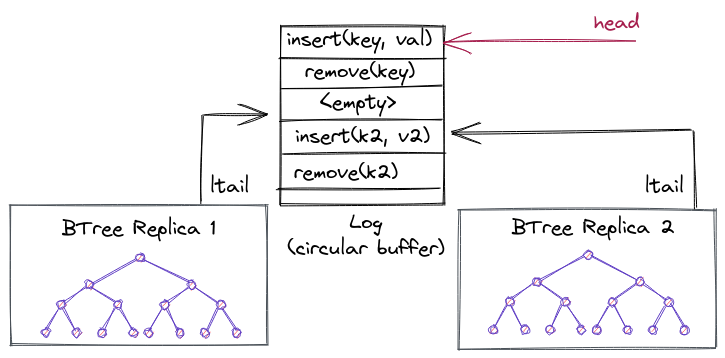
Next, we're going to explain the log in more detail for the curious reader (Warning: if you're not directly working on this, likely these subsections are pretty boring and can be skipped as well).
Log memory layout
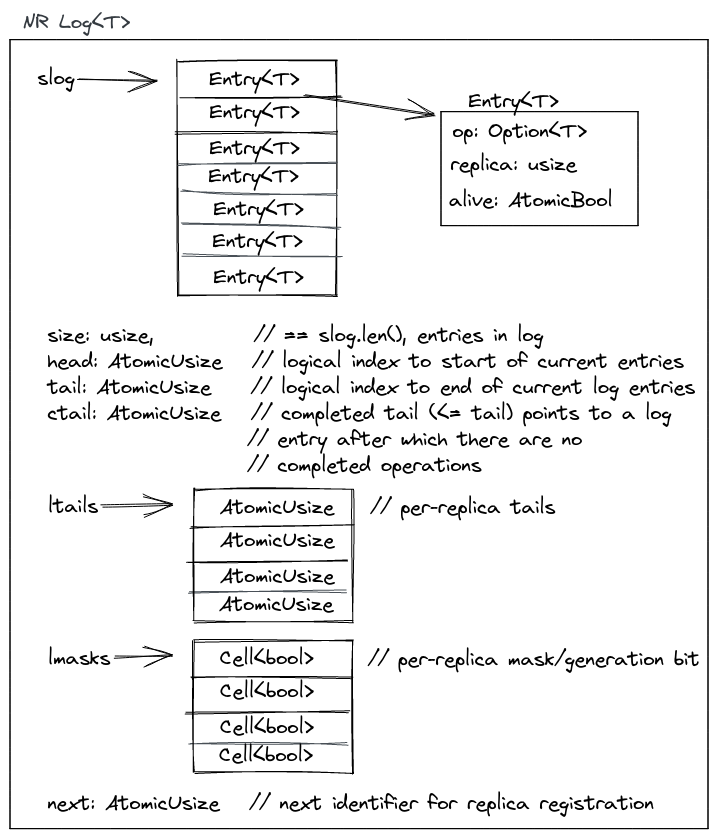
The
log
contains an array or slice of entries, slog, where it stores the mutable
operations from the replicas. It also maintains a global head and tail which
are a subregion in slog, and indicate the current operations in the log that
still need to be consumed by at least one replica or have not been garbage
collected by the log. The head points to the oldest "active" entry that still
needs to be processed, and the tail to the newest. All replicas have their own
ltail which tracks per-replica progress. At any point in time, an ltail will
point somewhere in the subregion given by head..tail. lmasks are generation
bits: they are flipped whenever a replica wraps around in the circular buffer.
next is used internally by the library to hand out a registration tokens for
replicas that register with the log (this is done only in the beginning, during
setup). It tracks how many replicas are consuming from/appending to the log.
The ctail is an optimization for reads and tracks the max of all ltails:
e.g., it points to the log entry (< tail) after which there are no completed
operations on any replica yet.
Consuming from the log
The exec
method
is used by replicas to execute any outstanding operations from the log. It takes
a closure that is executed for each outstanding entry, and a token to identify
the replica that calls exec.
Approximately, the method will do two things:
- Invoke the closure for every entry in the log which is in the sub-region
ltail..tailand afterwards setsltail = tail. - Finally, it may update the
ctailifltail > ctailto the new maximum.
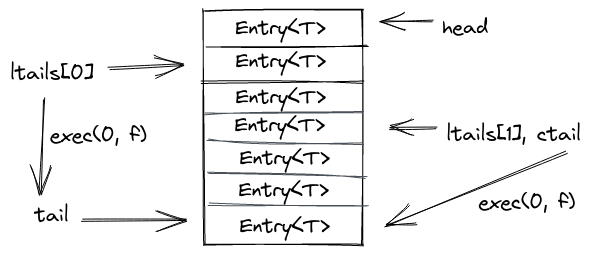
Appending to the log
The append
operation
is invoked by replicas to insert mutable operations into the log. It takes a
slice of new operations coming from the replica and the same closure as in
exec to potentially apply some outstanding operations. This is necessary as
the log could be full and unable to insert more operations. Then, we'd first
have to update our own ltail a bit (or wait for other replicas to make
progress).
Approximately, the method will end up doing these steps:
- If there isn't enough space to insert our new batch of operations, try to consume some entries from the log until we have enough space available.
- Do a compare exchange on the log
tailto reserve space for our entries. - Insert entries into the log
- See if we can collect some garbage aka old log entries no longer used (next section).
Garbage collecting the log
advance_head
has the unfortunate job to collect the log garbage. Luckily this amounts to as
little as periodically advancing the head pointer.
For that it computes the minium of all ltails. If this minimum still ends up
being the current head, it waits (and calls exec to try and advance its local
tail). Once the min ltail is bigger than the head, it will update the head to
that new minimum ltail and return.
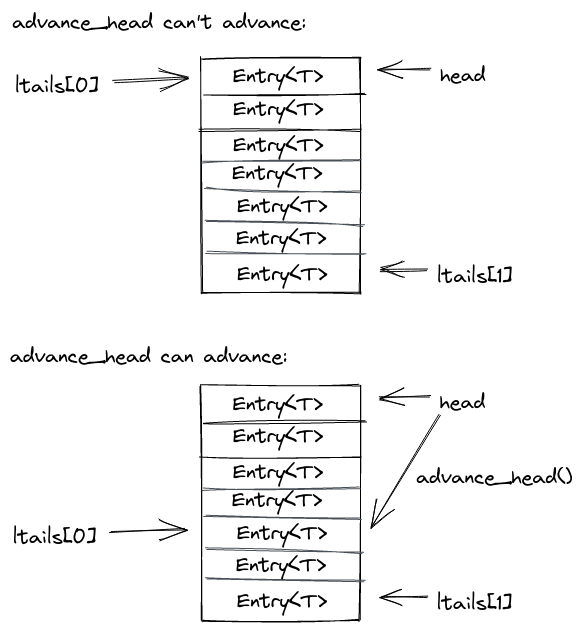
Flat combining
NR uses flat combining to allow threads running on the same socket to share a replica, resulting in better cache locality both from flat combining and from maintaining the replica local to the node's last-level cache.
-
The combiner can batch and combine multiple operations, resulting in a lower overall cost than executing each operation individually. For example, removing items from a priority queue can be done with a single atomic instruction for the whole batch instead of one atomic instruction for each operation.
-
A single thread accesses the data structure for multiple consecutive operations, ensuring cache locality for the whole batch of operations.
NR also benefits from combining operations placed on the log; the combiner does so using a single atomic operation for the whole batch instead of one atomic instruction per operation.
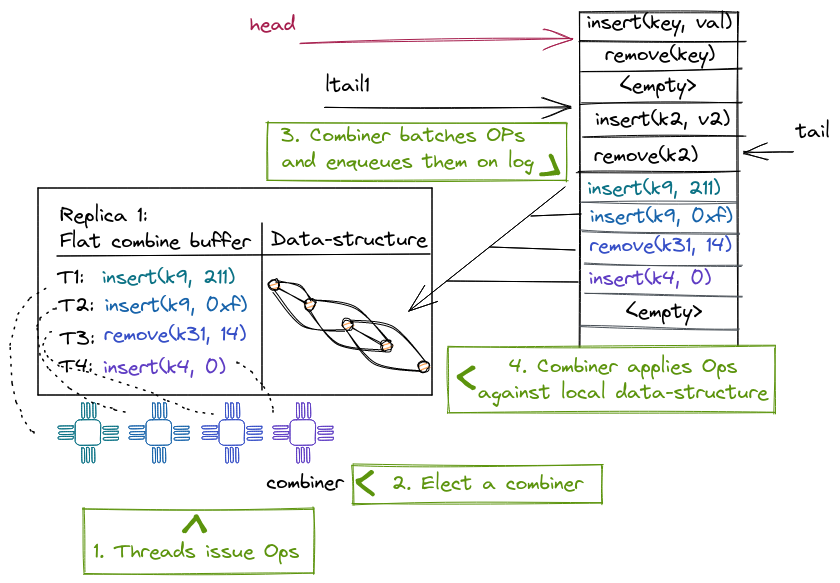
The optimized readers-writer lock
NR uses a writer-preference variant of the distributed RW lock to ensure the correct synchronization of the combiner and reader threads when accessing the sequential replica.
Each reader acquires a local per-thread lock; the writer has its own writer lock to indicate to the readers its intent to acquire the writer lock. A reader first checks the writer lock and then acquires its local lock if there is no writer; then it checks the writer lock again (while holding the lock) and releases the reader lock if it notices the writer declared its intent to acquire the lock (writer preference). The combiner also acquires the writer lock before modifying the replica. Thus, we give highest priority to the writer, because we don't want to delay update operations. This lock allows readers to read a local replica while the combiner is writing a batch of operations to the log, increasing parallelism.
If there is no combiner, a reader might have to acquire the writer lock to update the replica from the log to avoid a stale read, but this situation is rare.
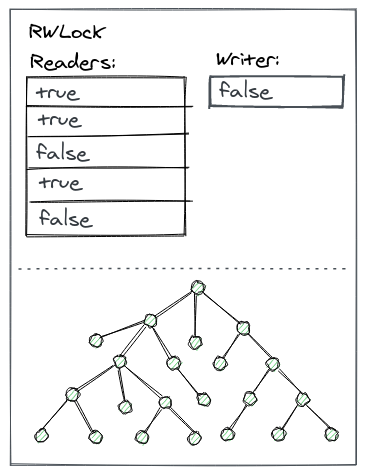
A concurrent non-mutating operation (read)
A non-mutation operation (read) can execute on its thread's local replica, without creating a log entry, but it needs to ensure that the replica is not stale. To do so, it takes a snapshot of the log tail when the operation begins, and waits until a combiner updates the replica past the observed tail, or acquires the lock and updates the replica.
If there is no combiner, the read thread will acquire the writer lock and update the replica.
A concurrent mutating operation (update)
A thread T executing a mutating operation (update) needs to acquire the combiner lock. If the thread T executing this operation fails to acquire it, another thread is a combiner already and T spin-waits to receive its operation's result from the existing combiner.
However, T must still periodically attempt to become the combiner, in case the prior combiner missed T's operation.
If T acquires the lock, it becomes the combiner and executes all update operations of the concurrent threads on the same replica. To do so, T appends its operations to the shared log with a single atomic operation and ensures that the replica is up to date, before executing the operations and returning their results to the waiting threads.
Source and code example
Node-replication (NR) is released as a stand-alone library.
To give an idea, here is an example that transforms an single-threaded hash-table (from the Rust standard library) into a concurrent, replicated hash-table:
#![allow(unused)] fn main() { //! A minimal example that implements a replicated hashmap use std::collections::HashMap; use node_replication::Dispatch; use node_replication::Log; use node_replication::Replica; /// The node-replicated hashmap uses a std hashmap internally. #[derive(Default)] struct NrHashMap { storage: HashMap<u64, u64>, } /// We support mutable put operation on the hashmap. #[derive(Clone, Debug, PartialEq)] enum Modify { Put(u64, u64), } /// We support an immutable read operation to lookup a key from the hashmap. #[derive(Clone, Debug, PartialEq)] enum Access { Get(u64), } /// The Dispatch traits executes `ReadOperation` (our Access enum) /// and `WriteOperation` (our `Modify` enum) against the replicated /// data-structure. impl Dispatch for NrHashMap { type ReadOperation = Access; type WriteOperation = Modify; type Response = Option<u64>; /// The `dispatch` function applies the immutable operations. fn dispatch(&self, op: Self::ReadOperation) -> Self::Response { match op { Access::Get(key) => self.storage.get(&key).map(|v| *v), } } /// The `dispatch_mut` function applies the mutable operations. fn dispatch_mut(&mut self, op: Self::WriteOperation) -> Self::Response { match op { Modify::Put(key, value) => self.storage.insert(key, value), } } } }
As we can see we need to define two operation enums (Modify for mutable
operations that end up on the log, and Access for immutable/read operations).
Afterwards we need to implement the Dispatch trait from NR for our newly
defined data-structure that mainly is responsible to route the operations
defined in Access and Modify to the underlying data-structure. The full
example,
including how to create replicas and a log can be found in the NR repository.